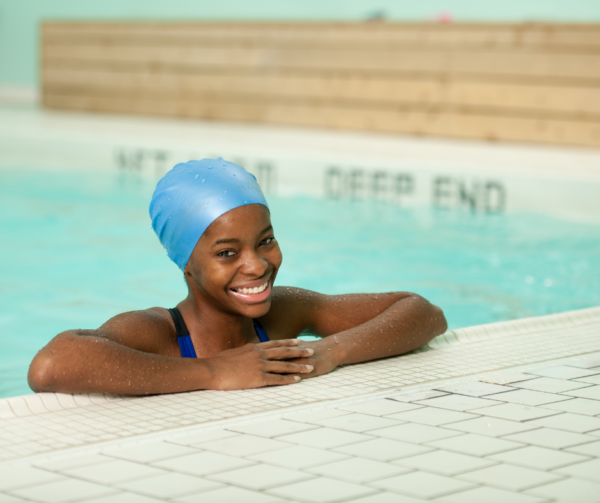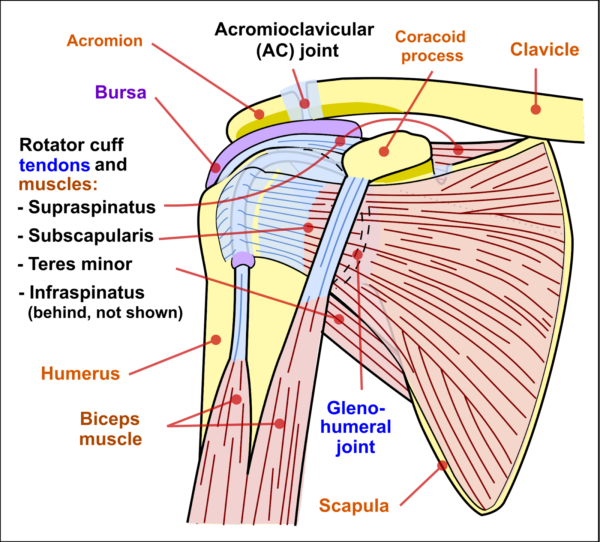By Coach Kelly Rose Thomas, DPT

The shoulder girdle is amazing! How many other regions of the body are you able to lift, lower, cross in front and in back of your body, rotate, and swing? The number of nerves, arteries, veins, muscles, ligaments, and bones in the shoulder area is astonishing (and a bit of a nightmare to learn).
To help familiarize you with the basics, here’s a brief review of some important players:
- Bones & Joints: the shoulder has 4 joints and includes the sternoclavicular joint (collar bone meets the sternum), the acromioclavicular joint (acromion of scapula meets collarbone), glenohumeral joint (upper arm meets the glenoid of the scapula) and the scapulothoracic joint (the gliding of the shoulder blade over the upper back; not a true joint)
- Muscles and fascia: These extend from the arm, back, and neck attach to the bones of these joints, actively stabilizing and moving the arm in all directions
- Ligaments: These help provide important passive stability to the joints.
In this article, we briefly explore 4 factors that can contribute to shoulder pain, and some exercises that can help promote a more positive relationship among these factors.

What Causes Shoulder Injury?
The shoulder is the most common site of injuries for swimmers. Athletes swimming 3000 meters, 3x per week, take approximately 500,000 strokes per arm, annually. Intrinsic and extrinsic factors can contribute to shoulder injuries. Intrinsic factors include individual anatomy, posture and core stability, abnormal/uncoordinated scapular motion, and strength imbalances. Extrinsic factors include training volume, poor stroke technique, use of paddles.
1. Posture.
Imagine there is a string attached to your head. Stand tall and raise your arms with your thumbs pointed up, 2 to 3 times (don’t arch your back while trying this- keep ribcage over pelvis). Note how that feels and how far you can lift your arms.
Now stand slouched, with your head forward and shoulders rolled in. Raise your arms 2 to 3 times in this posture. How does that feel compared to tall posture? Are you able to raise your arms the same with both postures?
Try lifting your arms with your thumbs pointed down. How does this compare to the thumbs up?
We recommend incorporating exercises that promote a taller posture and extension of the thoracic spine, open your chest cavity and allow better movement of the arm!
2. Muscular imbalance.
Swimmer’s have well developed internal rotator muscles of the shoulder, but their external rotators are often less developed. Think of the latissimus dorsi muscle of an elite swimmer. This huge muscle extends, internally rotates, and adducts the arm. It’s nicknamed the “handcuff muscle” because the action is the same as the “hands behind your back” arrest position (it also attaches to the bottom of the scapula).
Rotator cuff strengthening exercises with an emphasis on shoulder external rotation can help balance the strong internal rotators of the shoulder.
3. Stabilization.
Core and scapular stabilization are very important for swimming. Planks with upper and lower body movements, push-ups with a plus, and movements in different planes, challenge the kinetic chain.
If traditional planks are difficult for you, you can do them with your knees touching the floor or your arms on the wall, counter, or bed. BOSU and Swiss Balls offer additional challenges.
4. Swim technique.
A swim analysis is the best way to identify the technique errors you are making while swimming. For example, if your thumb is pointed down when your hand enters the water, or your hand crosses the black line, your shoulder moves into a very internally rotated and uncomfortable position.
Try focusing on a pinky or ring finger hand entry into the water, then keeping your left arm on the left side of the black line (and right arm on the right side of the black line). Also, allow your shoulder blade to move through your stroke. If you are experiencing shoulder pain, ditch the paddles UNLESS your coach is having you use them for a few laps, without force, to help bring awareness to your hand position in the water.
Be Smart.
The shoulder girdle is VERY complex, and posture, muscle balance, scapular stabilization, and swimming technique are all very important to a healthy shoulder. Symptoms are rarely due to one factor; a big picture view is necessary.
If you experience shoulder discomfort, pain, loss of range of motion, numbness, tingling, or other symptoms in your arm, schedule an appointment with a physical therapist for a thorough evaluation and individualized plan.
If you have any questions, feel free to email me at kthomas.dpt@gmail.com.
Thank you for taking the time to read; swim happy, one stroke at a time!
References:
Donaldson A, and Nabhan D. Orthopedic Management of the Swimmer- Orthopedic Management of the Runner, Cyclist, and Swimmer independent study course. Orthopedic Section, American Physical Therapy Association. 2013; 1-27.
Riewald S. The Biomechanics of Swimming- Orthopedic Management of the Runner, Cyclist, and Swimmer independent study course. Orthopedic Section, American Physical Therapy Association. 2013; 1-39.
